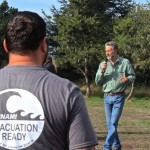During September, National Preparedness Month, the Austin Joint Field Office is releasing a series of stories highlighting FEMA’s support of Texas communities as they take steps to reduce or eliminate long-term risk to people and property.
AUSTIN, Texas – Austin’s city leaders have seen disaster before and understand the folly of waiting and hoping one will never again hit this area.
With that in mind, they partnered with Travis County and the Central Texas Chapter of the American Red Cross to develop “Disaster Ready Austin.” Coordinated by the city of Austin’s Office of Homeland Security and Emergency Management (HSEM), the purpose of the initiative is to educate and empower residents to be prepared for emergencies and disasters.
The vision is a whole-community approach to disaster preparedness education in the city of Austin. “Our basic message to [residents] is to protect themselves,” said Jacob Dirr, public information and marketing officer of HSEM’s Community Preparedness Programs. “The goal is to educate Austin residents on basic preparedness for all types of hazards, including first aid tips and what to do in case of flash floods, wildfires, severe weather, pandemic flu or accidents involving hazardous materials.”
Online resources, such as contact cards and emergency kit checklists are offered in English and Spanish at Homeland Security and Emergency Management | AustinTexas.gov . The HSEM Community Education and Outreach team members take advantage of scheduled meetings, such as Parent Teacher Associations (PTA) gatherings at the schools, where they offer presentations in English and Spanish.
Dirr notes that in some areas young kids, and parents, in the Austin community understand Spanish more than English.
Other audiences include Boy Scout groups, elderly care facilities, fairs, kids’ summer programs, area employers, community groups and school events.
One component of their community outreach at events is “Ready Freddie,” a character included in a children’s activity book called “Too Prepared to Be Scared,” which Dirr said is popular with parents and children. Featuring puzzles, games and animated figures to help get the preparedness message across, the booklet also has a certificate of appreciation children can receive when they finish.
“It’s full of colorful disaster-related advice such as information on developing an emergency supply kit, having an emergency plan and keeping pets safe,” Dirr said.
One of the biggest events attended by HSEM staff, including Dirr dressed in a life-size Ready Freddie mascot costume, was the “Back to School Bash” held at the downtown convention center. More than 100 vendors participated, with attendance exceeding 11,000.
To learn more about how cities and towns across Texas are building stronger, safer communities visit Best Practice Stories | FEMA.gov.
###
FEMA’s mission is to support our citizens and first responders to ensure that as a nation we work together to build, sustain, and improve our capability to prepare for, protect against, respond to, recover from, and mitigate all hazards.




